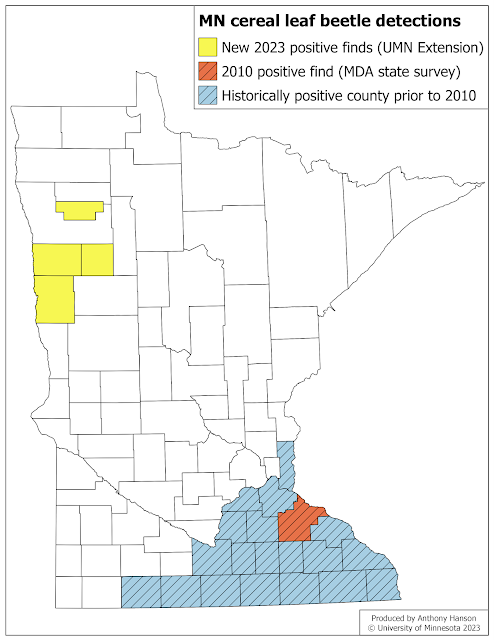February 2024
By Anthony Hanson, Regional Extension Educator - Field Crops Integrated Pest Management
Usually around this time of year I start to make some predictions about how cold has affected our pest insects. Instead, it’s been so warm this winter with only a relatively minor weeklong cold snap that pest forecast maps are not going to be very informative. Warm winters like this can allow pests that could not normally survive the winter to persist here, and this can also increase concerns about invasive pests.
One invasive insect I’ve been keeping an eye on in west-central and northwest Minnesota is cereal leaf beetle. During June 2023, University of Minnesota Extension field scouts started finding cereal leaf beetle in wheat and barley fields in Clay, Mahnomen, Norman, and Red Lake counties. Some of the highly infested fields had between 25 to 33% of plants with cereal leaf beetle larvae feeding on the leaves and causing significant potential for yield loss.
This insect damages wheat and other small grain leaves at stages when yield can be drastically reduced. The larvae, or immature beetles, have a fairly disgusting habit though, and that’s saying a lot coming from an entomologist. These larvae carry their frass, the term for insect poop, on their mucus-covered back as a defense against predators (Figs. 1 & 2). This slime, like honeydew from aphids, can be an annoyance for farmers or field scouts as they walk in heavily infested fields.
The cereal leaf beetle is native to Europe and was first detected in the U.S in Michigan in the early 1960’s. Since then, the insect has spread through the eastern states, west to Montana, south to Missouri and east to Virginia. It has been reported in southern MN, primarily east of the Minnesota River Valley, but we believe this is the first reporting of cereal leaf beetle from northern Minnesota (Fig.3). Economically damaging infestations haven't been widely reported in Minnesota yet, but finding these beetles in northwestern counties so far from previously known finds does raise concern that it may be present in other areas of the state. It is also possible these beetles moved in across the border from North Dakota where they also are documenting more finds of this insect.

This leaves the question of what’s happening in small grains fields for those of us in west-central Minnesota. Has cereal leaf beetle just not shown up here yet, or is it present in low-level populations that just haven’t been noticed yet? Like with many invasive insects, we sometimes don’t notice how widespread a new insect is until they’re established enough to cause widespread problems. Scouting programs with UMN Extension are supported by farmers, such as Minnesota wheat growers, to help detect pests like this. If farmers are seeing what appear to be slug-like grubs on their wheat plants, they should contact their local extension office. If you have wheat fields in western Minnesota and would like to volunteer them for our pest scouts from Morris, Moorhead, or Crookston to visit please visit this submission form.
For more information on cereal leaf beetle scouting and management from the University of Minnesota Extension, visit: https://z.umn.edu/cerealleafbeetle. Email Anthony at [email protected].
